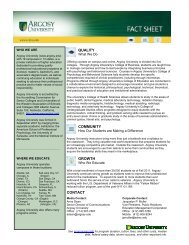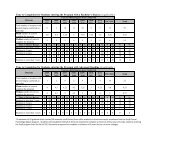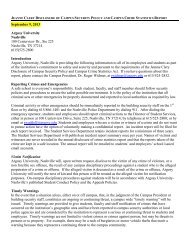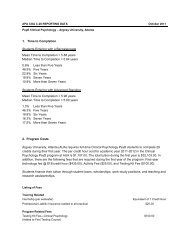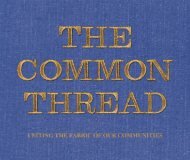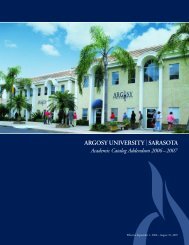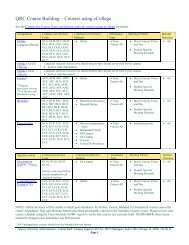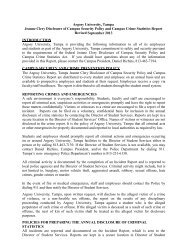crime report - Argosy University
crime report - Argosy University
crime report - Argosy University
Create successful ePaper yourself
Turn your PDF publications into a flip-book with our unique Google optimized e-Paper software.
NATURAL DISASTERS<br />
Flood<br />
Floods are the most common and widespread of all natural disasters--except fire. In flood<br />
situations, the following should be followed:<br />
If the flooding is caused by a pipe break, sink overflow or other plumbing problem:<br />
1. During normal business hours, notify security and/or a member of the CMT.<br />
2. Try to identify the source of the water and turn it off if this can be done safely.<br />
If the flooding is caused by heavy rains or winter snow thaw:<br />
1. During normal business hours, notify security and/or a member of the CMT.<br />
Attempt to close doors and windows to prevent additional water from entering the<br />
building, if possible.<br />
2. Focus resources on minimizing the spread of water to other areas of the building.<br />
3. If able:<br />
a. Protect property and records by removing items from floors and /or covering<br />
items with water-resistant coverings.<br />
b. Move items of value to higher ground.<br />
c. Unplug electrical equipment such as computers, printers, etc. if it is safe to do so.<br />
If electrical circuits appear to be getting wet, leave the area immediately.<br />
4. If immediate evacuation is necessary, use the fire alarm system to notify building<br />
occupants.<br />
Tornado<br />
It is virtually impossible to outrun a tornado; therefore, one should seek shelter whenever a<br />
tornado warning is issued.<br />
The National Weather Service issues severe weather warnings using the following terms:<br />
- A “tornado watch” means that tornadoes could develop in the designated area.<br />
- A “tornado warning” means that a tornado has actually been sighted in the area or is<br />
indicated by radar.<br />
- A “severe thunderstorm watch” indicates the possibility of thunderstorms, frequent<br />
lightning and/or damaging winds, hail, and heavy rain.<br />
- A “severe thunderstorm warning” means that a severe thunderstorm has actually been<br />
sighted in the area or is indicated by radar.<br />
Tornadoes occur with little or no warning; thus, little or no advance planning can be<br />
accomplished.<br />
If in a building, one should move away from outside rooms and go to a center hallway. An<br />
interior area at the bottom level of the building is preferable. One should avoid buildings with<br />
wide, free span roofs. If caught outside with no time to reach an inside shelter, lie flat in the<br />
nearest ditch, ravine, or culvert, with hands and arms shielding one’s head. Be sure to leave the<br />
ditch, ravine, or culvert immediately after the tornado has passed to avoid the possibility of flash<br />
flooding. If in an automobile, follow the same rules as outlined above.<br />
Earthquake<br />
During an earthquake, remain calm and quickly follow these steps:<br />
1. If indoors, seek refuge in a doorway or under a desk or table. Stay away from glass<br />
windows, shelves, and heavy equipment.<br />
2. If outdoors, move quickly away from buildings, utility poles and other structures.<br />
3. Caution: Always avoid power or utility lines as they may be energized. Know your<br />
assembly location and proceed there as soon as it is safe to do so..<br />
42



